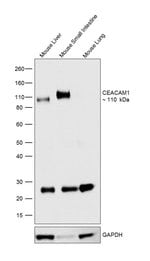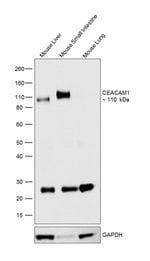Learn More
Invitrogen™ CD66a (CEACAM1) Monoclonal Antibody (CC1), eBioscience™, Invitrogen™
Mouse Monoclonal Antibody
Marke: Invitrogen™ 14-0661-82
Beschreibung
Description: The monoclonal antibody CC1 recognizes CD66a, also known as carcinoembryonic antigen-related cell adhesion molecule 1 (CEACAM1), biliary glycoprotein, and BPG. Expression of CD66a is found on brush borders, epithelial, and endothelial cells. In hematopoietic cells expression is found abundantly on B cells, as well as some NKs, monocytes, DCs, and granulocytes. Although low levels of mRNA have been identified in T cells in humans, resting mouse T lymphocytes are not reported to express CD66a, as confirmed by lack of staining with CC1 antibody. In humans, expression levels of CD66a have been used to identify maligcies. CD66a plays a key role as a regulator of BCR activation of B lymphocytes. An alternate allele, CEACAM1b, is expressed in SJL mice; therefore, CC1 does not stain SJL tissue. The monoclonal CC1 has been shown to block viral infection and also enhance B cell proliferation when combined with IgM crosslinking. Applications Reported: This CC1 antibody has been reported for use in flow cytometric analysis, and immunohistology staining of paraffin embedded tissue sections. Applications Tested: This CC1 antibody has been tested by flow cytometric analysis of mouse splenocytes. This can be used at less than or equal to 0.25 μg per test. A test is defined as the amount (μg) of antibody that will stain a cell sample in a final volume of 100 μL. Cell number should be determined empirically but can range from 10^5 to 10^8 cells/test.
CEACAM1 is a member of the carcinoembryonic antigen (CEA) gene family, which belongs to the immunoglobulin superfamily. Two subgroups of the CEA family, the CEA cell adhesion molecules and the pregnancy-specific glycoproteins, are located within a 1.2 Mb cluster on the long arm of chromosome 19. Eleven pseudogenes of the CEA cell adhesion molecule subgroup are also found in the cluster. The encoded protein was originally described in bile ducts of liver as biliary glycoprotein. Subsequently, it was found to be a cell-cell adhesion molecule detected on leukocytes, epithelia, and endothelia. The encoded protein mediates cell adhesion via homophilic as well as heterophilic binding to other proteins of the subgroup. Multiple cellular activities have been attributed to the encoded protein, including roles in the differentiation and arrangement of tissue three-dimensional structure, angiogenesis, apoptosis, tumor suppression, metastasis, and the modulation of innate and adaptive immune responses. Multiple transcript variants encoding different isoforms have been reported, but the full-length nature of only two has been determined.
Spezifikation
| CD66a (CEACAM1) | |
| Monoclonal | |
| 0.5 mg/mL | |
| PBS with 0.09% sodium azide; pH 7.2 | |
| P31809 | |
| CEACAM1 | |
| Affinity Chromatography | |
| RUO | |
| 26365 | |
| 4°C | |
| Liquid |
| Flow Cytometry, Functional Assay, Immunohistochemistry (Paraffin), Western Blot | |
| CC1 | |
| Unconjugated | |
| CEACAM1 | |
| antigen CD66; ATP-dependent taurocolate-carrier protein; bb-1; BGP; BGP1; BGP-1; BGPI; BGPR; Biliary glycoprotein 1; biliary glycoprotein D; bone gamma-carboxyglutamic acid (Gla) protein; carcinoembryonic antigen 1; carcinoembryonic antigen 7; carcinoembryonic antigen related cell adhesion molecule 1; carcinoembryonic antigen-related cell adhesion molecule 1; carcinoembryonic antigen-related cell adhesion molecule 1 (biliary glycoprotein); Cc1; C-CAM; C-CAM 105; Ccam1; CD66a; CD66a antigen; Cea1; Cea-1; Cea7; Cea-7; CEACAM1; CEA-related cell adhesion molecule 1; CEA-related cell adhesion molecule 1 (bone gamma-carboxyglutamic acid (Gla) protein) (osteocalcin); Cell-CAM 105; ecto-ATPase; GP110; hepatitis virus (MHV-4) susceptibility; hepatitis virus receptor; Hv2; Hv-2; mCEA1; Mhv-1; MHVR; MHV-R; MHVR1; mmCGM1; mmCGM1a; mmCGM2; murine hepatitis virus receptor; osteocalcin; pp120; pp120/ecto-ATPase | |
| Mouse | |
| 100 μg | |
| Primary | |
| Mouse | |
| Antibody | |
| IgG1 κ |
Bitte geben Sie uns Ihr Feedback zu den Produktinhalten, indem Sie das folgende Formular ausfüllen.
For Research Use Only.







